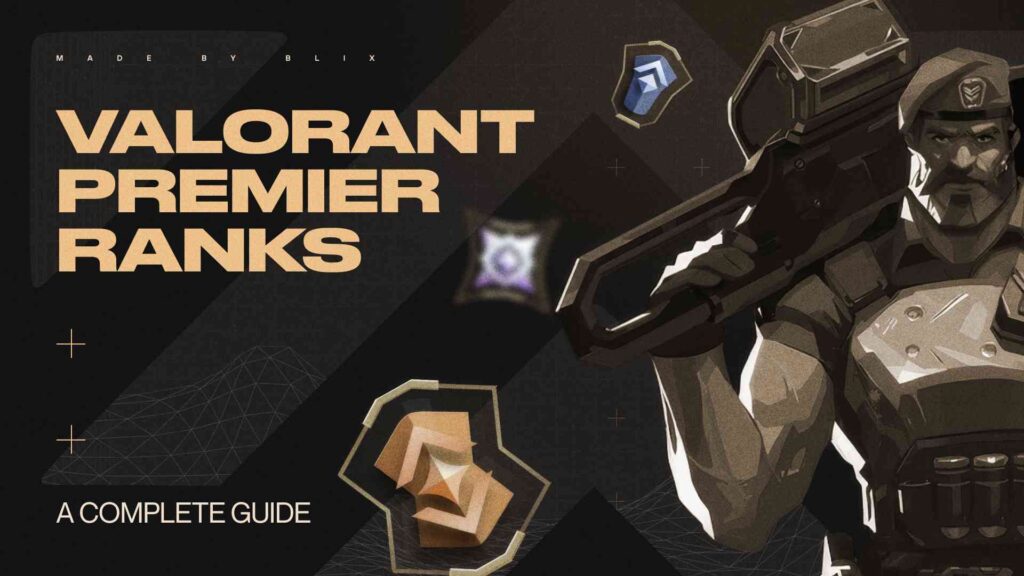The Blix team writes many different pieces about Vallorant. Look into the “Valorant Ranks Order, Distribution, Ranking System Explained” article. But first off, we already explained what Valorant Premier is. Given that we could not omit the Valorant Premier ranks and everything connected. Understand the Valorant Premier ranking system with our complete guide.
Learn about different ranks, how to rank up, and get on the leaderboard. Improve your gameplay with expert tips and strategies! This guide answers critical questions about how Valorant Premier ranks work, the distribution of players across different tiers, and practical strategies for ranking up.
Contents
- 1 Highlights
- 2 Introduction
- 3 Overview of Valorant Premier Ranks
- 4 Ranks Explanation
- 5 Progression and Points System
- 6 Rank Distribution in Valorant Premier
- 7 How to Rank Up in Valorant Premier
- 8 Importance of Consistent Performance and Teamwork
- 9 How Wins, Losses, and Individual Performance Affect Ranking
- 10 Valorant Premier Tiers and Divisions
- 11 Importance of Divisions
- 12 Valorant Premier Leaderboard
- 13 Common Challenges and How to Overcome Them
- 14 Conclusion
- 15 What Do Users Usually Ask About Valorant Premier Ranks?
- 16 How does the ranking system work in Valorant Premier?
- 17 What are the different ranks in Valorant Premier?
- 18 How do I rank up faster in Valorant Premier?
- 19 What is the highest rank in Valorant Premier?
- 20 How is the Valorant Premier leaderboard calculated?
- 21 What are the rewards for ranking up in Valorant Premier?
Highlights
- Detailed explanation of Valorant Premier
- Summary of the Premier Ranks
- Description of Divisions and its use
- Tips and advice for easier ranking
Introduction

Valorant Premier
Valorant Premier is Riot Games’ premier competitive mode, designed to provide a structured pathway for players to progress from casual play to professional esports. Players compete in weekly matches in teams of five to seven players to qualify for a playoff tournament and determine a champion. Understanding the ranking system is crucial for players aiming to climb the ranks, improve their skills, and eventually compete at higher levels. This guide offers a comprehensive overview of the Valorant Premier ranking system, structure, and how players can effectively rank up.
Overview of Valorant Premier Ranks
The Valorant Premier ranking system categorizes players based on skill and performance for fair competition and progress tracking. It is divided into five main groups, each containing multiple divisions. These ranks accurately reflect a player’s skill level and ensure balanced matchmaking. The main groups and their respective divisions are as follows:
- Open (1-5)
- Intermediate (1-5)
- Advanced (1-5)
- Elite (1-5)
- Contender
Ranks Explanation
Each rank group serves as a stepping stone, guiding players through their competitive journey from beginners to top-tier competitors.
Open Rank
This rank is for players still learning and improving their skills in the game. Advancing through the Open divisions means mastering gameplay mechanics and performing consistently in matches.
Intermediate Rank
Players at this level have moved beyond basic skills and are starting to refine their strategies. They are better at communication, teamwork, and adapting to different game situations. Climbing through intermediate divisions requires consistent performance and a deep understanding of the game’s strategic elements.
Advanced Rank
Skilled Valorant players excel in using different agents, maps, and playstyles. Advancing in the Advanced rank requires individual skill, strong team coordination, and strategic planning.
Elite Rank
This rank includes top players almost ready to turn pro. They dominate matches with superior skills and strategies. Elite players practice and study high-level play to stay ahead. Climbing through these divisions is challenging and requires exceptional performance in every match.
Contender Rank
The contender rank in Valorant is the highest level of achievement in Valorant Premier, and it is reserved for the best players. It requires outstanding skills, team coordination, and strategic thinking. The competition is intense, with players aiming to enter professional esports.
Progression and Points System
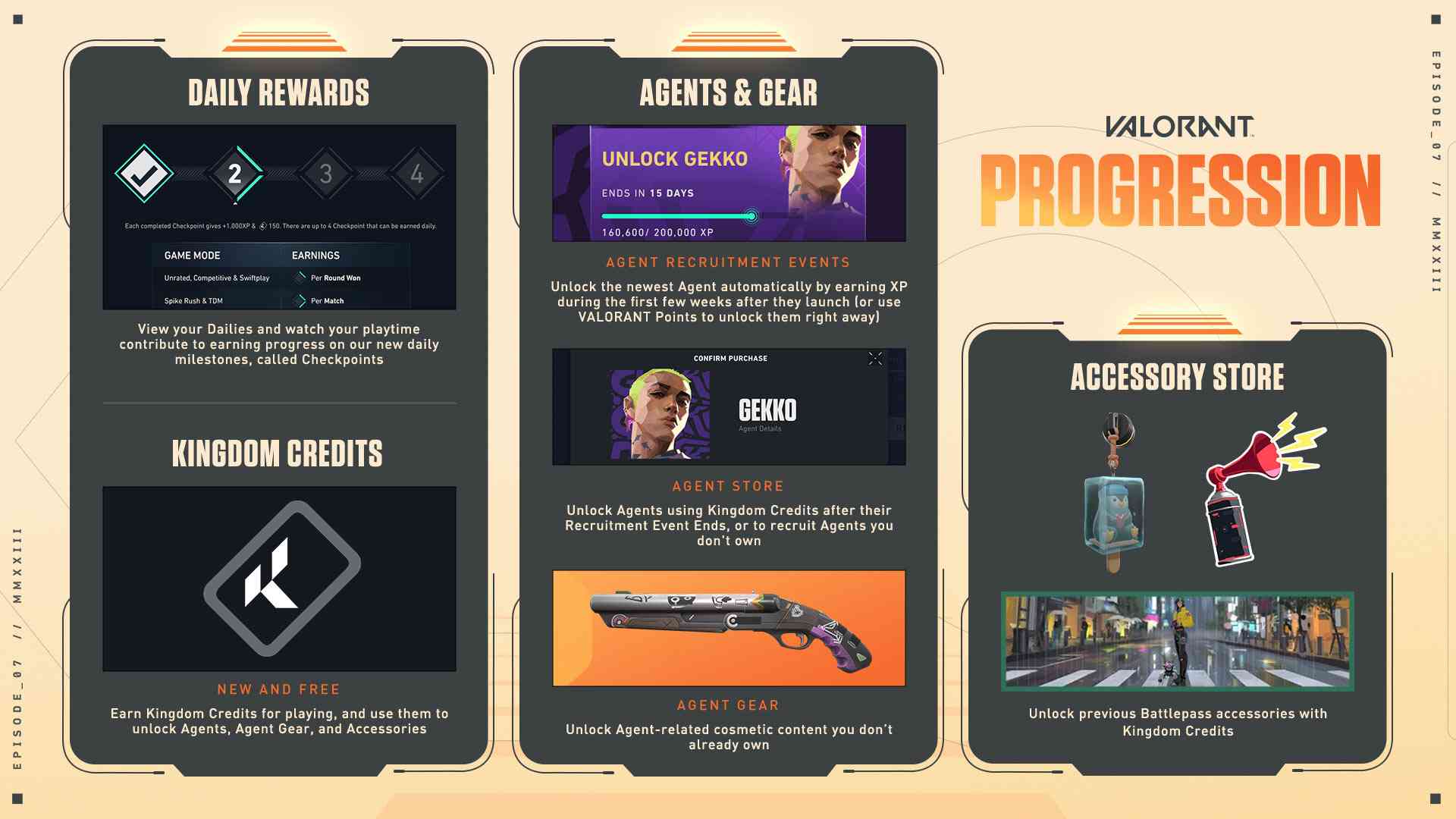
Progression and rewards
Players progress through the ranks by earning points from match victories. These points determine their position within a division and their potential to advance. The system rewards consistent performance and teamwork.
Earning Points
Players earn points by winning matches. Each win contributes points towards moving up to the subsequent division. The better your performance, the faster you accumulate points.
Advancing Divisions
Players who earn enough points move up through the divisions. For example, a player in Intermediate 5 who consistently wins matches will progress to Intermediate 4, Intermediate 3, and so on until they reach Intermediate 1.
Promoting to a Higher Tier
Once players reach Division 1 of their current Tier and continue to win matches, they can be promoted to the next Tier. For instance, a player in Intermediate 1 can advance to Advanced five after accumulating sufficient points and proving their skill at the top of the Intermediate Tier.
Impact of Losses
Losses can result in losing points, which may cause players to drop divisions if they fail consistently. For example, a player in Advanced 2 who experiences a string of losses may drop to Advanced three or lower divisions within the Advanced Tier. However, the system also considers overall performance, so occasional losses won’t drastically affect the ranking if a player’s performance remains strong’’.
Rank Distribution in Valorant Premier
The distribution of players across different ranks in Valorant Premier can provide insights into the competitive landscape. Typically, most players are concentrated in the lower and mid-tier ranks, with fewer players reaching the higher tiers like Elite and Contender. Currently, there are no Premier Rank distribution statistics, but certain numbers about the size of the primer are available:
How to Rank Up in Valorant Premier
Ranking up in Valorant Premier involves a mix of strategic gameplay, individual skill improvement, and effective teamwork. Here’s how you can improve your rank:
Consistent Practice
Regular practice is critical. Use training modes to hone your shooting accuracy, reflexes, and familiarity with different agents and maps. Consistency in practice leads to muscle memory and better in-game performance. Still, Premier requires time and may not suit random people.
Effective Communication
Valorant is a team game. Good communication with your team can make a significant difference. Use voice or text to share information about enemy positions and strategies and coordinate plays.
Strategic Gameplay
Develop a deep understanding of game mechanics and map layouts. Use this knowledge to plan strategies, control choke points, and anticipate enemy movements. Use agent abilities effectively to support your team and disrupt the enemy.
Adaptability
Be ready to adapt your playstyle based on the match’s flow and the opponents’ tactics.
Flexibility with agent selection and in-game strategies can give your team a tactical advantage.
Review and Improve
Analyze your gameplay after matches. Watching replays can help you identify mistakes and areas for improvement. Pay attention to positioning, aim accuracy, and decision-making processes during critical moments.
Mindset
Maintain a positive attitude, even in losses. Treat each match as a learning experience. Staying calm and composed can help you make better decisions under pressure.
Importance of Consistent Performance and Teamwork
Consistent performance is crucial for ranking up. Valorant Premier rewards players who consistently perform well in matches. This means regularly contributing to your team’s success by securing kills, assists, and playing objectives. High-performing players often have better in-game awareness, positioning, and decision-making skills.
Teamwork is equally essential. Successful teams communicate effectively, plan their strategies, and support each other during matches. A well-coordinated team can outperform a group of highly skilled but uncoordinated players. Building good chemistry with your team and understanding each player’s strengths and weaknesses can lead to more consistent wins and a higher rank.
How Wins, Losses, and Individual Performance Affect Ranking
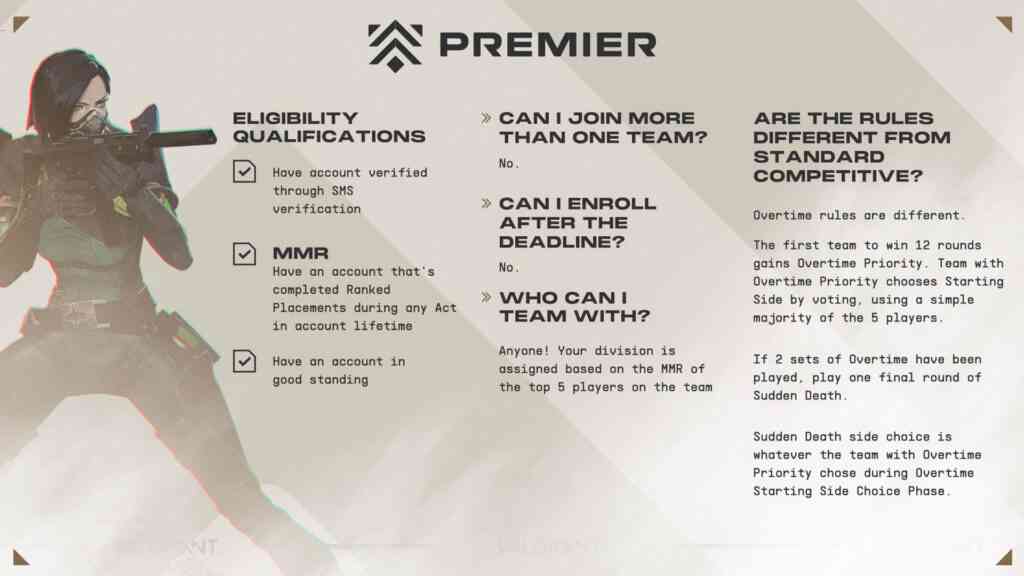
Premier teams and MMR FAQ
In Valorant Premier, your rank is influenced by both team performance and individual contributions. Here’s how they impact your ranking:
Wins and Losses
Winning matches is the primary way to earn ranking points and move up divisions. Each win contributes significantly to your rank progression, while losses can slow your progress or even cause you to drop ranks. However, the system considers the overall win-loss record over time rather than short-term fluctuations’.
Individual Performance
Individual performance also plays a role in ranking. Players who consistently perform well, securing kills, assists, and achieving objectives, will likely see faster rank progression. Valorant’s ranking system considers factors such as kill/death ratio, damage dealt, and objective contributions. Performing well even in losing matches can mitigate the negative impact on your rank’.
Matchmaking Rating (MMR)
Behind the scenes, Valorant uses a Matchmaking Rating system to assess your skill level. MMR adjusts based on your match performance and determines your opponent’s quality. A higher MMR increases your chances of playing against more vigorous opponents, which can accelerate your rank progression if you continue to perform well.
Valorant Premier Tiers and Divisions
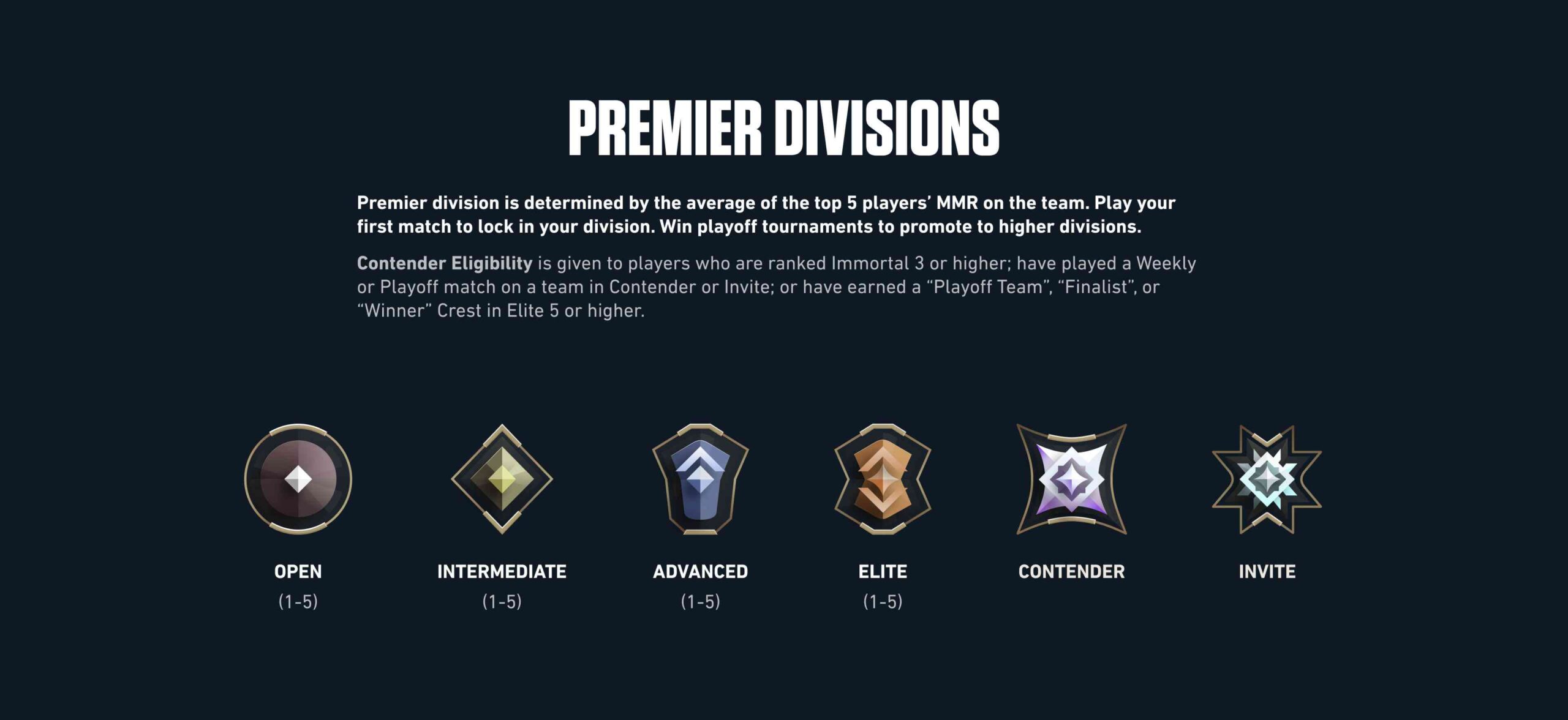
Premier Divisions
Divisions are subcategories within each rank tier in Valorant Premier that provide a more detailed assessment of a player’s skill level and progress. They are designed to offer frequent milestones and help ensure balanced matchmaking. Here’s a detailed explanation:
Granular Progress Measurement
Each Tier (Open, Intermediate, Advanced, Elite, Contender) is divided into five divisions, 1 through 5. Division 1 is the highest within its Tier, and Division 5 is the lowest. This granularity allows more precise measurement of a player’s skill and progress within a tier.
Ranking System
Players start at a lower division within their Tier and must earn points through match victories to advance to higher divisions. For example, a player might begin at Intermediate 5 and progress through Intermediate 4, Intermediate 3, and so on, up to Intermediate 1.
Promotion and Demotion
Players can be promoted to the next higher Tier once they reach Division 1 of their current Tier and continue to perform well. Conversely, if players consistently lose matches, they may drop to a lower division within their Tier, from Intermediate 2 to Intermediate 3.
Impact on Matchmaking
Divisions help match players against opponents of similar skill levels, maintaining competitive balance and fairness. This system means that players within the same or close divisions will likely face each other, providing a consistent challenge appropriate to their skill level.
Frequent Milestones: Divisions provide short-term goals for players. Moving from one division to the next offers a sense of achievement and progression, encouraging continuous improvement and engagement with the game.
Importance of Divisions
Skill Reflection
Divisions reflect a player’s current skill level more accurately than broader tiers alone. This helps identify strengths and areas needing improvement.
Motivation
Regularly achieving new divisions keeps players motivated. Each promotion within a tier is a rewarding experience that drives further engagement.
Balanced Gameplay
The system ensures balanced and fair gameplay by matching players within similar divisions. This balance is crucial for maintaining the competitive integrity of matches and ensuring that players face appropriate challenges.
Ranking System Integrity
The division system helps maintain the integrity of the overall ranking system by preventing abrupt and drastic changes in rank due to short-term performance fluctuations. Players need to demonstrate consistent performance to move up or down in divisions.
Valorant Premier Leaderboard
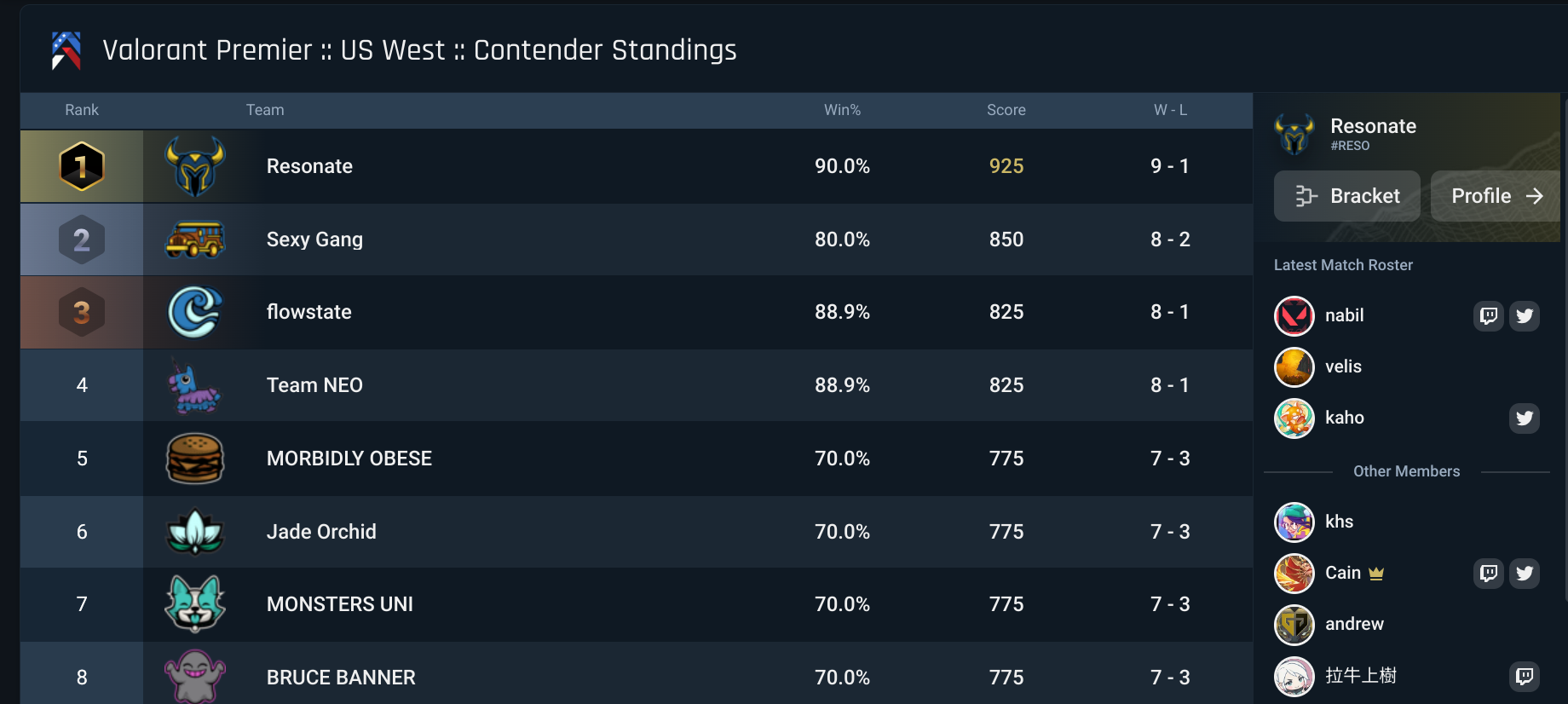
US West Standings
The leaderboard in Valorant Premier showcases the top teams and players within each division and zone. To get on the leaderboard, teams must consistently perform well in their matches, accumulating points that contribute to their Premier Score. The leaderboard is updated regularly by different dedicated trackers.
Common Challenges and How to Overcome Them
Players often face several challenges when trying to rank up in Valorant Premier. Here are some common obstacles and strategies to overcome them:
Inconsistent Team Play
Ensure all team members are on the same page with strategy and communication. Regular practice sessions help improve team synergy.
Tilt and Frustration
Manage tilt by taking breaks and maintaining a positive outlook. Focus on the aspects of the game you can control.
Skill Gaps
Continuously work on improving individual skills such as aim, movement, and game sense through dedicated practice and training modes.
Adaptation to Meta
Stay updated with the current meta and be willing to adjust your playstyle and agent picks accordingly’.
Conclusion
VALORANT Premier Explained – What You Need To Know
Understanding the Valorant Premier ranking system is essential for players who aspire to climb the ranks and improve their gameplay. By familiarizing themselves with the rank structure, distribution, and practical strategies for ranking up, players can enhance their performance and enjoy Valorant Premier’s competitive experience. Use this guide’s tips and insights to navigate your journey through the ranks and aim for the top tiers.
What Do Users Usually Ask About Valorant Premier Ranks?
How does the ranking system work in Valorant Premier?
The ranking system in Valorant Premier is designed to assess and reflect players’ skill levels through a tiered structure. Players start in lower divisions and must win matches to earn points, which helps them climb through the divisions within their rank. The system ensures players compete against others of similar skill levels, making matches fair and competitive’.
What are the different ranks in Valorant Premier?
Valorant Premier features a range of ranks divided into five main groups, each with five divisions:
- Open 1-5
- Intermediate 1-5
- Advanced 1-5
- Elite 1-5
- Contender
Each rank group signifies a different skill level, with Open being the starting point and Contender being the highest and most competitive Tier’.
How do I rank up faster in Valorant Premier?
To rank up faster in Valorant Premier, aim for consistent kills, assists, and objective plays. Effective communication and teamwork are crucial. Be flexible in your strategies and agent picks, and analyze your gameplay after each match for improvement. Maintain a positive mindset, learn from losses, and stay motivated for continuous improvement.
What is the highest rank in Valorant Premier?
The highest rank in Valorant Premier is Contender. This rank represents the top echelon of players with exceptional skill and teamwork. Reaching Contender requires consistent high-level play and success against other top-ranked teams’.
How is the Valorant Premier leaderboard calculated?
The Valorant Premier leaderboard is calculated based on the Premier Score, which teams earn through match victories. Each win contributes points to the team’s Premier Score, determining their standing on the leaderboard. The leaderboard is regularly updated to reflect the latest performance data, showcasing the top teams within each division and zone’.
What are the rewards for ranking up in Valorant Premier?
Ranking up in Valorant Premier offers several rewards, including prestige, recognition, and exclusive in-game items like skins and titles. Higher ranks and leaderboard positions can also lead to qualification for larger tournaments and entry into professional circuits.


